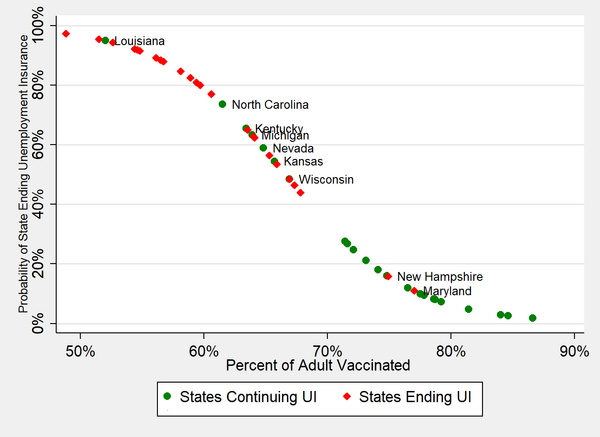As part of the pandemic response in March 2020, the United States enhanced and extended unemployment insurance (UI) through the CARES Act by adding $600 a week to the regular state unemployment benefit through July 6th, 2020. As part of the American Rescue Plan Act, federal policymakers extended eligibility for UI and approved an option for states to allow an additional $300 a week through September 6th, 2021.
Many state governors chose to withdraw from the federal program, ending the additional support to the unemployed in their states, even before the federal program ended. A withdrawal from the program decreases payments by $300 weekly and reintroduces limits on eligibility (gig workers, for example, would no longer qualify).
The enhanced unemployment insurance should end at some point, as it was always supposed to be a stop-gap solution for the pandemic and not a permanent policy. And while policymakers should take steps to reform unemployment insurance so that it is responsive to similar events in the future, the pandemic enhancements were drawn up in an emergency context and are unlikely to represent the best policy design in the long run. As such, we should not be surprised to see governors withdraw from the UI enhancements as vaccination rates rise, and states turn their focus to the economic recovery.
The exact opposite has occurred, however. The states that are ending the enhancements to unemployment insurance are the very states that have, to date, vaccinated the fewest people.
The World Turned Upside Down
While there is no hard-and-fast rule, epidemiologists have suggested that herd immunity to Covid will occur when approximately 70 percent of the population has been vaccinated.[1] Twenty states have met or exceeded this threshold in the adult population. Ninety percent of these states (all but two, New Hampshire and Maryland) are maintaining unemployment insurance through September. On the other hand, of the 30 states that have failed to hit the 70 percent population threshold, 23 are withdrawing from pandemic unemployment. Only seven states where herd immunity has not been reached (Kansas, Kentucky, Louisiana, Michigan, Nevada, North Carolina, and Wisconsin) plan to continue providing enhanced unemployment benefits through September.
This is illustrated in the graph below. The x-axis shows each state’s vaccination rate. The y-axis shows the result of a logistic regression, drawing out the current patterns of a state’s decision to end unemployment based solely on their vaccination rate. The graph shows a strong relationship: with the exceptions noted above, the states are neatly sorted between those who have vaccinated a sufficient population to reach herd immunity (and are continuing to use enhanced unemployment) and those that have failed to do so (and are ending unemployment insurance early).

While people may differ on how and when states should end unemployment insurance, it would be defensible if states like Vermont (86.6 percent adult vaccination rate) or Hawaii (84.6 percent adult vaccination rate) began phasing out the benefits earlier. But instead, we see support being withdrawn in Mississippi (48.8 percent adult vaccination rate) and Wyoming (51.5 percent adult vaccination rate), arguably the states which need it the most, and where promoting a rapid return to work risks exposing workers to an outbreak.
It is unclear what is driving governors to make decisions that are so incongruous with the context of their state’s pandemic response. Some may be overly influenced by their state’s business community, hoping to dampen employee demands for higher wages. Others may be concerned about potential revenue shortfalls.
Regardless, this points to a major shortfall of the current state-run unemployment insurance system. It suggests that under the current system governors may have too much discretion, and may be driven to make decisions that are not in their state’s best interest. As policymakers consider potential reforms to unemployment insurance in the aftermath of the coronavirus pandemic, they should consider how to restructure the unemployment insurance system in ways that either limit this discretion, or give state programs more appropriate incentives.
[1] Leshem, E., & Lopman, B. A. (2021). Population immunity and vaccine protection against infection. The Lancet, 397(10286), 1685-1687.